|
In the News |
 |
Ancient footprints found in Mexico valley
MEXICO CITY - A trail of 13 fossilized
footprints running through a valley in a desert in northern Mexico could be
among the oldest in the Americas, Mexican archeologists said.
The footprints were
made by hunter gatherers who are believed to have lived thousands of years
ago in the Coahuila valley of Cuatro Cienegas, 190 miles (306 kms) south of
Eagle Pass, Texas, said archaeologist Yuri de la Rosa Gutierrez of Mexico's
National Institute of Anthropology and History.
(Follow the Link. Get the whole
story . . . ) |
 |
 |
Invaluable papyrus published at last
Scholars turned out in
force on Thursday night for the launch of the first full edition of the
Derveni Papyrus at the Archaeological Museum of Thessaloniki.
The oldest book in Europe,
the Derveni Papyrus is an Orphic, eschatological text that discusses the
fate of the soul and the role of the Furies. A mystic, often allegorical
text, it was written in the last quarter of the fourth century BC. Scholars
who have studied it describe it as «the most significant new evidence about
ancient Greek philosophy and religion since the Renaissance.
(Follow the Link. Get the whole
story . . . ) |
 |
 |
200,000 years for all trace of Man to vanish from the Earth
Light pollution would be the first
to go, followed by fields, buildings and cities
IF MAN were to vanish from
the face of the Earth today, his footprint on the planet would linger for
the mere blink of an eye in geological terms.
Within
hours, nature would begin to eradicate its impact. In 50,000 years all that
would remain would be archaeological traces. Only radioactive materials and
a few man-made chemical contaminants would last longer — an invisible
legacy.
(Follow the Link. Get the whole
story . . . ) |
 |
 |
Human figures, wild animal
reliefs unearthed
in 11,000-year-old Göbeklitepe
tumulus
ANKARA - Turkish Daily News
A team
of archaeologists working at the Göbeklitepe tumulus in the southeastern
city of Şanlıurfa came across human figures without heads as well as reliefs
of scorpions, snakes and wild birds on obelisks belonging to the Neolithic
period, the head of the team announced on Monday.
Speaking at a press conference at the ancient city, excavation team
leader Klaus Schmidt of the German Archeological Institute in Berlin stated
that Göbeklitepe was an 11,000-year-old site of worship established by the
hunter-gatherer people of the time.
(Follow the Link. Get the whole
story . . . )
|
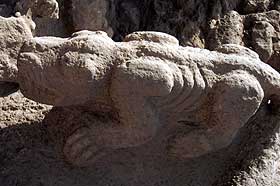 |
 |
Rapid Sea Level
Rise in the Arctic Ocean May Alter Views of Human Migration
Scientists have found
new evidence that the Bering Strait near Alaska flooded into the
Arctic Ocean about 11,000 years ago, about 1,000 years earlier than
widely believed, closing off the land bridge thought to be the major
route for human migration from Asia to the Americas.
(Follow the Link. Get
the whole story . . . )
|
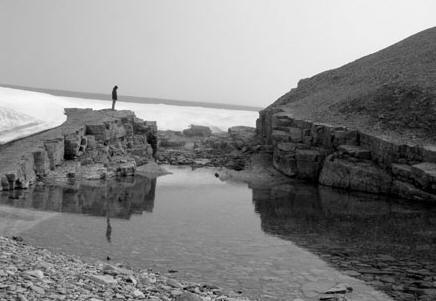 |
 |
Human skulls are
'oldest Americans'
Tests on skulls found in Mexico
suggest they are almost 13,000 years old - and shed fresh light on how
humans colonised the Americas.
The human skulls are the
oldest tested so far from the continent, and their shape is set to inflame
further a controversy over native American burial rights.
(Follow the Link. Get the whole story . . . )
|
 |
 |
Tourists flock to Bosnian hills; experts mock amateur archaeologist's
pyramid claims
In Bosnia's Valley of the Pyramids, only one man is
king. Semir Osmanagic, new-age philosopher and amateur archaeologist, splits
his time between Texas and Sarajevo, but these days is mostly to be found
scraping away at a hillside 40 minutes north of the Bosnian capital.
It is here that he claims to have made the most
extraordinary discovery of the millennium: Europe's only pyramids, dating
back to the late Ice Age, exceeding in scale and perfection those of ancient
Egypt or Latin America. "This is the most magnificent construction complex
built on the face of the planet," he said. "These pyramids are so old and so
unique, it's hard to compare them to anything else in the world."
(Follow the Link. Get the whole story . . . ) |
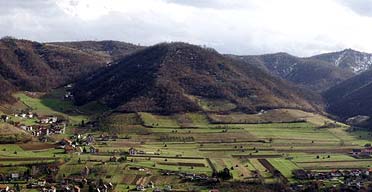 |
 |
Researchers link ice-age climate-change records to ocean salinity
Using chemical traces in
fossil
shells of microscopic planktonic life forms, called formanifera, in deep-sea
sediment cores, scientists reconstructed a 45,000- to 60,000-year-old record
of ocean temperature and salinity. They compared their results to the record
of abrupt
climate
change
recorded in ice cores from Greenland. They found the Atlantic got saltier
during cold periods, and fresher during warm intervals.
"The freshening likely reflects shifts in rainfall patterns, mostly in the
tropics," Howard Spero of the
University
of
California
at Davis said. "Suddenly, we're looking at a record that links
moisture
balance in the tropics to climate change. And the most striking thing is
that a measurable transition is happening over decades."
(Follow the Link. Get the whole story . . . )
|
 |
 |
Archaeologists
find 11-millennium-old building in Syria
DAMASCUS (AFP) - Archaeologists said they
have discovered an 11-millennium-old building with on the banks
of the Euphrates River in northern Syria.
"A remarkable discovery has just been
uncovered of a large circular building dating
back to 8,800 BC near (the locality of)
Ja'de," the head of the French archaeologal team that made the
find told AFP.The building, much
larger than normal houses, "had a collective use, probably for
all of the village or a group," Eric Coqueugniot said.
(Follow the Link. Get the whole story . . . ) |
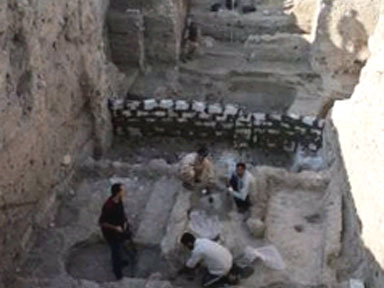 |
 |
Delving deep into Britain's
past
Scientists are to begin work on the second phase
of a project aimed at piecing together the history of human colonisation in
Britain.
Phase one of the Ancient Human Occupation of
Britain project (AHOB) discovered people were here 200,000 years earlier
than previously thought.
Phase two has now secured funds to the tune of Ł1m
and will run until 2010.
Team members hope to find out more about Britain's
earliest settlers and perhaps unearth their fossil remains.
(Follow the Link. Get the whole story . . . ) |
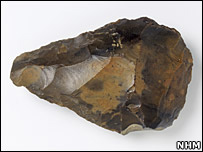 |
 |
9,500-year-old decorated skulls found in Syria
24 September 2006
DAMASCUS - Archaeologists said
Sunday they had uncovered decorated human skulls dating back as long
as 9,500 years ago from a burial site near the Syrian capital
Damascus.
“The human skulls date back between
9,500 and 9,000 years ago, (on which) lifelike faces were modelled
with clay earth ... then coloured to accentuate the features,” said
Danielle Stordeur, head of the joint French-Syrian archaeological
mission behind the discovery.
(Follow the Link. Get the whole story . . . ) |
 |
 |
Scientist: Humans Strange, Neanderthals Normal
Neanderthals
are often thought of as the stray branch in the human family tree, but
research now suggests the modern human is likely the odd man out.
"What people
tend to do is draw a line from our ancestors straight to ourselves, and any
group that doesn't seem to fit on that line is divergent, distinct, unusual,
strange," researcher Erik Trinkaus, an anthropologist at Washington
University in St. Louis, told
LiveScience today. "But in terms of
evolution of
our family tree, the genus
Homo, we're the outliers and the
Neanderthals are more toward the core."
Humans are not
at the inevitable end of a sequence, Trinkaus said. "It just happens that we
happen to be alive today and Neanderthals are not."
(Follow the Link. Get the whole story . . . ) |
 |
|
|
|
   
  
©
All content copyright 2006 Mark Barnette. All
Rights Reserved.
|
















